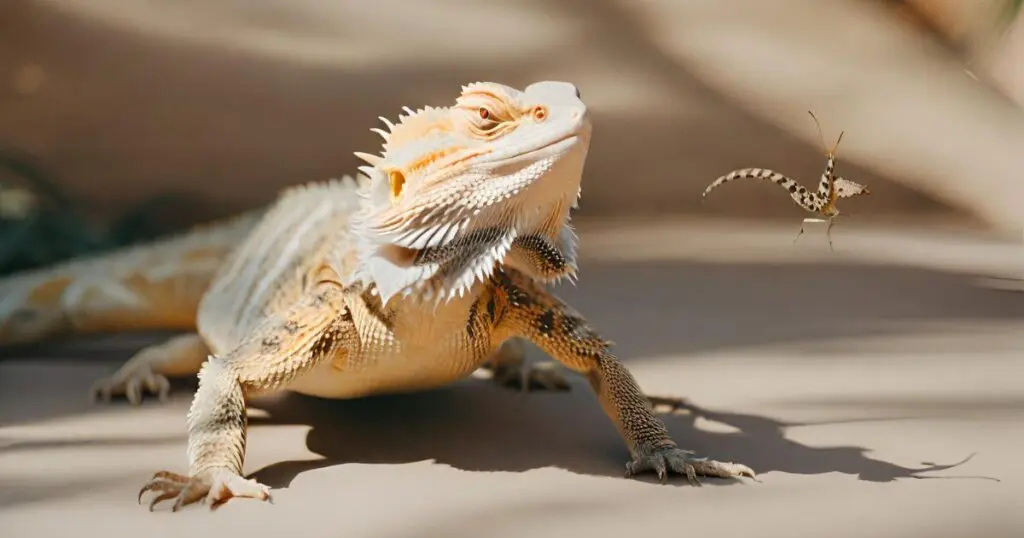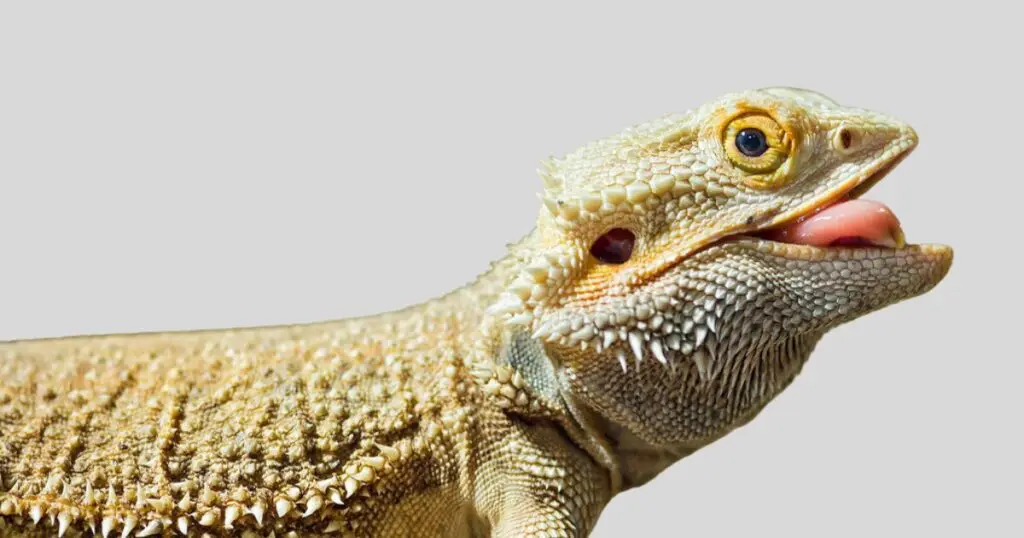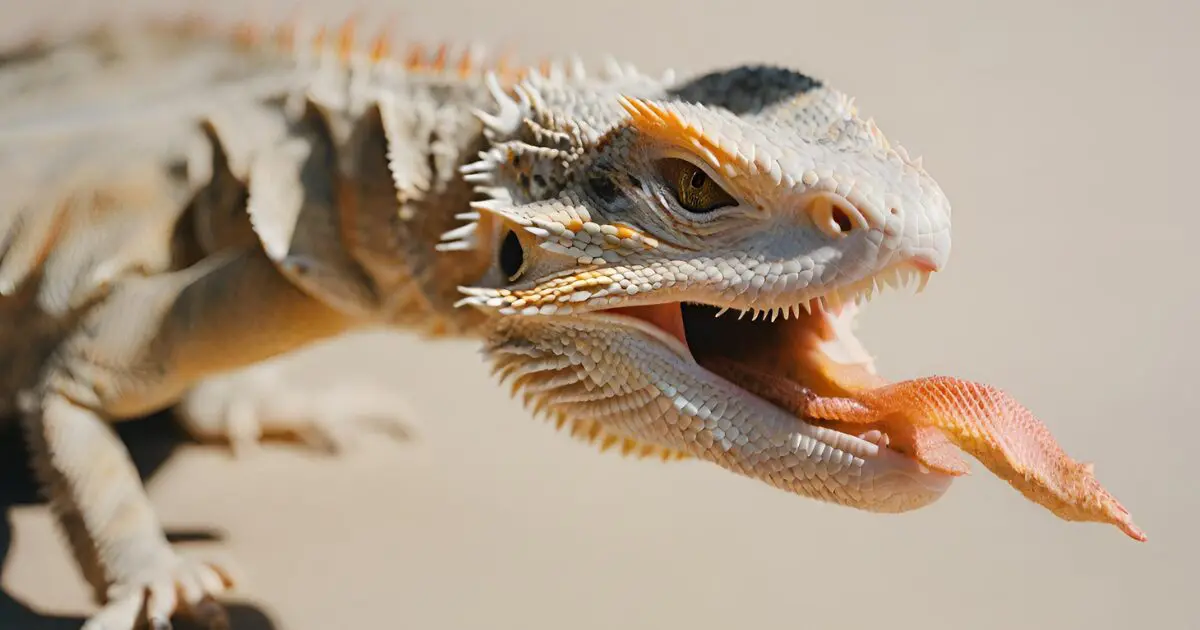I’m always interested in learning new facts about my bearded dragon, Spike. His behaviors and unique features never cease to amaze me. One thing I’ve wondered about is just how long is a bearded dragon’s tongue?
The average adult bearded dragon has a tongue that measures around 1 to 3 inches long. Their tongue is actually quite short compared to some other lizards. They don’t rely on their tongues for catching prey primarily.
The tongue performs various functions for them. From smelling and identifying foods to following a scent and catching prey, the tongue plays a crucial role.
Anatomy of Bearded Dragon’s Tongue
No, wait, I am not going to take a biology class. I know how boring it would be. Again, understanding the anatomy is important to understand the size and nature of the tongue. Let me describe it in some easy words.
1. Length and Width
A bearded dragon’s tongue is quite long compared to its head size. An adult dragon’s tongue is usually around 4 inches long when fully extended. Their tongues are long and skinny. It is roughly the width of a pencil at the base but tapering to a narrow tip.
This length helps them catch prey at a distance. The length also aids in drinking water and exploring their environment.
2. Texture and Coloration
The top surface of a bearded dragon’s tongue has a rough, bumpy texture. If touched, it feels like super fine sandpaper. This helps them grip food items when catching prey.
Their tongues are pinkish in color, sometimes with a blueish tint towards the tip. Often, the tongue tip is darker than the base. The tiny projections on the surface of the tongue give it a slightly mottled appearance.

3. Muscles and Skeletal System
A bearded dragon’s tongue contains intrinsic and extrinsic muscles. The intrinsic muscles allow the tongue to change shape. The extrinsic muscles connect the tongue to hyoid bones in the throat.
This bone and muscle structure allows the tongue to flex rapidly during feeding and retract back into the mouth. The hyoid bones act as an anchor point for tongue muscles.
4. Presence of Taste Buds
Yes, bearded dragons have taste buds on their tongues. The taste buds are concentrated at the tip and along the sides. They have receptors for sweet, bitter, salty, and sour tastes. Yes, they can taste the foods that they eat.
Their long tongue allows them to sample potential food items before swallowing. This helps avoid eating toxic or foul-tasting prey. Therefore, you should maintain a variation of their diet.
- Add fruits like kiwi, raspberries, dragon fruits, etc., occasionally.
- Give them insects on a regular basis, including mice
- Let them have leafy greens as well
What Is the Tongue Used for?
The tongue has many things to do. It aids in eating, catching, and more. This organ plays a vital role in their survival.
1. Hunting and Eating
A bearded dragon uses its long, flexible tongue to catch prey. When hunting, the dragon flicks its tongue out rapidly to gauge the location of prey. Once targeted, the sticky tongue darts out to snag food.
The rough texture helps grip insects, small rodents, or other prey items. Taste buds on the tongue identify if potential food is toxic before swallowing. The tongue manipulates food for swallowing and moves food around the mouth while chewing.
2. Sensory Abilities
The tongue collects chemical molecules from the air or ground to analyze scents and flavors. This assists bearded dragons in identifying:
- Food
- Predators
- Mates
- Rivals, and
- Favorable environmental conditions
Taste buds and chemoreceptors detect chemicals and transmit signals to the brain. The tongue constantly samples the environment, even when not eating. This tongue-flicking behavior helps build sensory maps of the habitat.
3. Maintaining Hydration
Bearded dragons use their tongue to drink water and absorb moisture. The tip of the tongue can quickly lap or scoop water from puddles, droplets, or damp leaves. Capillary action pulls water into the mouth from moist surfaces when touched by the tongue tip.
Hydration is quite important for these reptiles. It helps them:
- Regulate body temperature
- Aid digestion and avoid constipation and other digestive issues
- Support kidney function
- Maintain healthy skin
4. Body Temperature Regulation
Open-mouth panting helps dragons release excess body heat. The air passing over the moist mouth and tongue surfaces aids in evaporative cooling. Extending the tongue further increases air exposure. It boosts the cooling effect by enhancing blood circulation and transferring internal heat outward.
5. Cleaning and Grooming
Bearded dragons use their tongue to clean their eyes, nostrils, lips, and beards. The tongue removes dust, traces of food, unshed skin, and other debris.
The tongue distributes protective oils and moisture from glands over the skin and beard when grooming. Antimicrobial compounds in the saliva keep the mouth and beard bacteria-free.
6. Social Communication
Beardies use their tongue for social communication as well. The movement of the tongue can mean different things, such as:
- Territorial boundaries
- Breeding readiness
- Aggression
- Submission, etc.
How Does A Healthy Bearded Dragon Tongue Look Like?
A bearded dragon’s tongue can reveal a lot about its health. Here are the key features to look for in a healthy dragon’s tongue:
- Pinkish Color: The tongue should have a light pink tone. If it’s very pale, bright red, or has dark purple spots, it may indicate a health issue.
- Moist Appearance: A healthy tongue will appear moist but not overly wet. A sticky, tacky tongue could signal dehydration.
- No Growths: There should be no lumps, bumps, lesions, or other growths on a healthy tongue. These may be signs of infection.
- Even Color: The tongue color should look uniform with no major variations from base to tip. Patchy coloring may indicate fungal or bacterial infection.
- Smooth Surface: A healthy tongue will look smooth, with no wrinkles, cracks, or peeling skin. Irregularities can be caused by vitamin deficiencies.
- Active Movement: The tongue should move freely and retract fully back into the mouth. Limited motion can be a sign of neurological problems.
- No Odor: There should be no foul or unusual odors coming from the mouth or tongue. Strange smells may indicate mouth rot or other issues.
Common Tongue Issues for Bearded Dragons
Issues with the tongue can impact their quality of life. Here are some common tongue problems beardies may experience:

1. Tongue Injuries
Bearded dragon tongues can become injured from bites, cuts, abrasions, or puncture wounds. These are often caused by the dragons accidentally biting their own tongue. Sharp pieces of wood, rock, or other habitat decor can also damage the tongue if improperly placed.
Symptoms of tongue injuries include bleeding, swelling, redness, and discharge or pus if infection sets in. There may be difficulty eating due to pain. The dragon may exhibit unusual head movements from irritation.
Treatment involves keeping the wound clean by gently rinsing it with a reptile-safe disinfectant. Apply antibiotic ointment daily. For deep lacerations, seek veterinary care.
2. Beardie Cannot Retract the Tongue.
A bearded dragon that cannot retract its tongue back into its mouth properly is a serious health concern. This can lead to injuries and dehydration. Causes include mouth rot, neurological damage, severe dehydration, vitamin deficiencies, and muscle atrophy.
Symptoms include a protruding tongue that appears unable to pull back into the mouth. There may be associated discharge, weight loss, lethargy, or limb weakness.
Rehydrating the dragon and correcting vitamin levels can help. Antibiotic, antifungal, and steroid medications may be prescribed.
3. Difficulties in Hunting
Issues like malnourishment, vitamin deficiencies, mouth infections, and missing teeth can impair a dragon’s ability to catch prey. Symptoms include:
- Poor aim or tongue coordination when striking at food
- Dropping food items prematurely
- Reduced appetite
Improving nutrition, correcting vitamin levels, and treating infections can often resolve these feeding issues.
4. Tongue Flicking Abnormalities
Excessive, inadequate, or asymmetrical tongue flicking is not normal for them. It potentially indicates problems sensing the environment. Such behavior can be triggered by:
- Respiratory infections
- Neurological damage
- Vitamin deficiencies
- Dehydration
- High-stress levels
How to Take Care of a Bearded Dragon’s Tongue?
Caring for your bearded dragon’s tongue is important for its health. Here are some tips based on what has worked for my beardie:
- Check the tongue daily. Look for any cuts, bumps, or color changes. A healthy tongue should be moist and pink.
- Make sure the habitat has smooth decor without sharp edges. Sand down rough wood pieces to prevent tongue abrasions.
- Feed a chopped-up diet. Whole insects can bite the tongue. Chopped silkworms or hornworms are gentler options. Is your bearded dragon refusing to eat worms? Then, you may need to work on that, too.
- Provide fresh, clean water daily in a shallow bowl. This allows easy drinking to keep the tongue hydrated.
- Gently wipe the tongue with a warm, wet cloth to remove stuck shed skin. Never pull off the shed from the tongue.
- Use a hygiene spray after feeding to keep the mouth clean. Avoid mouthwash containing alcohol.
- Check for signs of dehydration or infection and see an exotic vet promptly if issues occur.
- Monitor the dragon after installing any new habitat accessories. Remove items that pose a tongue injury risk.
FAQ
Knowing the answers to the following questions hopefully will be helpful for you. I am reflecting on my knowledge, experience, and research here.
What is the normal color of a bearded dragon’s tongue?
The normal healthy color of a bearded dragon’s tongue is pink or light red. It may often have a bluish, purple, or black tint towards the tongue tip. An extremely pale white or bright ruby red tongue can signal illness like anemia or infection.
Why do bearded dragons have a split tongue?
Yes, bearded dragons have a forked or split tongue. Their twin tongue tips allow them to simultaneously sense chemicals in two separate areas as they flick their tongue. This grants more environmental awareness and aids in hunting insects and detecting predators for self-defense.
How many inches is a bearded dragon?
Yes, adult bearded dragons reach 16-24 inches nose to tail tip. Their body length is around 10-18 inches. Bearded dragons have long tongues, extending 3-4 inches from the mouth when fully stretched out. This tongue length aids in catching prey.
Is bearded dragon saliva toxic?
No, bearded dragon saliva is not inherently toxic or venomous like some snakes. However, their mouths do contain bacteria that can cause infections in humans if a bite breaks the skin. Proper handling hygiene and gentle restraint methods are important when interacting with bearded dragons.
Do bearded dragons have 2 tongues?
No, bearded dragons only have one single tongue inside their mouth. But the split or forked tip of the tongue functionally acts like two tongues. It allows them to collect chemical samples from two closely spaced contact points.
Conclusion
The tongue plays a crucial role in Beardie’s life. Knowing only how long a bearded dragon’s tongue is is not enough. You should be aware of the other important aspects as well. Do inspect their tongues on a regular basis to be sure of their health.
Follow the given instructions to maintain good tongue health. A strong and healthy tongue promotes their overall well-being.
